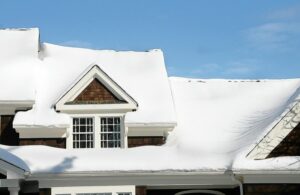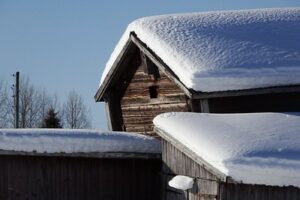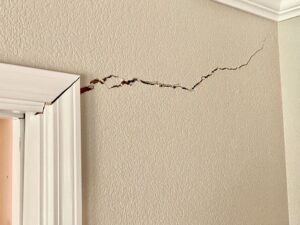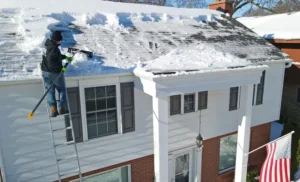Learn more about when you need to remove snow below.

SNOW REMOVAL FACTS
St. Louis for the most part doesn’t get so much snow that you will need to remove it yourself. We all know St. Louis weather, stick around a few days and it will change. Most roofs in the area are built to handle to little amount of snow that we do get. Snow removal is dangerous, even on the ground let alone on a roof. Removing snow from your roof could actually cause more damage than good.
Removing snow from your roof is more dangerous than you might think. Do not work alone. If you can’t see where you are throwing snow, like over the edge of a high flat roof. Have a spotter below who will keep pedestrians away and who can communicate with you with a cell phone. Clumps of hard snow or ice thrown from a third story flat roof can do serious damage to a person.
If you do clear a roof, do not try to remove the last layer of ice or snow that is attached to the roof. Remove the weight above it but leave that layer to protect the roof membrane or shingles. Going right down to the roof will most likely cause the roof to leak when things begin to thaw.
Also be aware that any guide-line that simply says remove snow after 6 or 12 inches of accumulation. They are not taking into account the actual weight of the snow. Think about shoveling snow, you know that there is light snow and there is heavy snow. In fact snow weight varies from fluffy flakes to heavy water soaked snow to solid ice. Even ice can be light or heavy depending on how much it is made up of air bubbles.

WHEN IS SNOW ON THE ROOF TOO MUCH SNOW?
So, when do you know how much is too much snow? The easiest indicator is to keep an eye on center-of-the-house doors, like the door to the bedroom upstairs. If it did not stick or jam at all before the snow (except perhaps seasonally in the humidity of the summer) and it does begin to stick as the snow accumulates. That is like a thermometer that says your house has a fever and there is a problem. Keep an eye open for new cracks in the plaster or drywall, usually near corners of those inside doorways.

FLAT RESIDENTIAL ROOF SNOW REMOVAL
If you have a flat basin roof which slopes to a central drain, it is “relatively” safe to work on. You can fall over the edge but you won’t just slide off the edge. If it is a flat roof that slopes to an edge you should take the same type of precautions that you should take on a steeper slopped roof. You can work from the edge and not get on the roof at all. You could also use a safety rope attached to a solid tree on the opposite side of the house. If needed you can buy or rent a harness. It is a harness that you see climbers or construction workers wearing that allows for the attachment of a rope. The rule of thumb is, one rope for your ladder, another rope for you.
There is a technique for throwing a rope over the roof. Use a fishing rod and reel to cast over the roof and then draw the rope back.
REMOVING THE SNOW
Snow can be moved down the roof, a little at a time working from the bottom edge towards the top. Ice should be removed working from the top of the roof down. The released ice will slide off the roof on ice, not sliding on exposed shingles. Rarely should you ever remove ice right down to the shingles or membranes. Leave a bit of a protective ice layer. That last little bit of ice is stuck to the roof covering. You can create water leaks trying to remove it.

Removal of ice from the edge of the roof is best done with non-salt chemical de-icers. Do not with hatchets or hammers. Chopping and cutting can cause more roof problems than all the ice during a big ice storm. Any ladders should be tied down on both sides to prevent slipping and tied to a line over the house so it can’t be pushed backwards by sliding snow. One last tip, never work alone.
Check out some more of our winter blogs, like the one about winterizing your home or this one for tips on putting up holiday lights. Stay warm out there this winter. It will be March before you know it!
